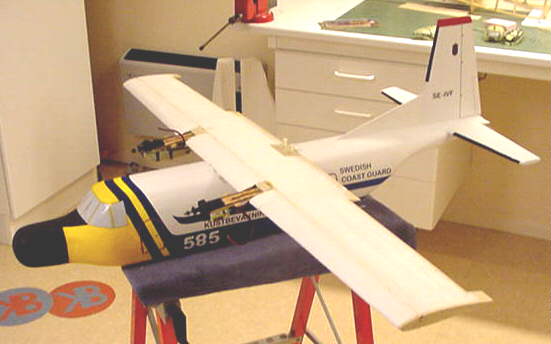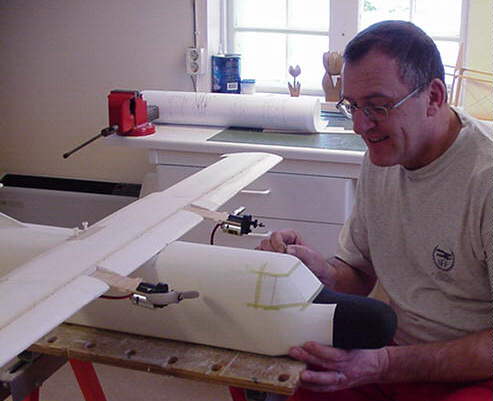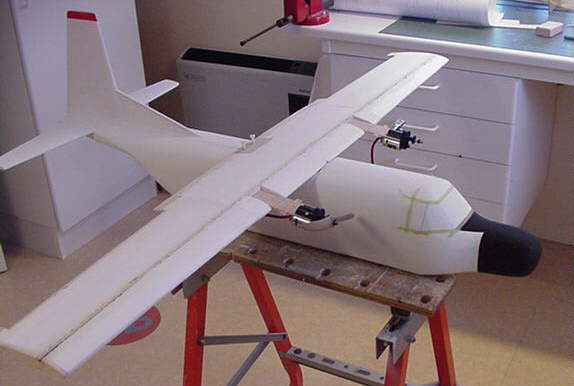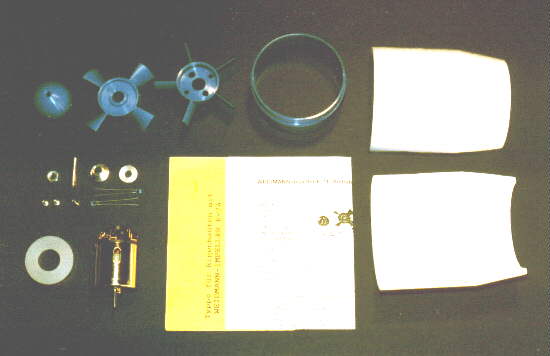 |
Flying High With Electric Power!
The Ampeer ON-LINE!
Fly the Future - Fly Electric! |
Site Table of Contents
| President: | Vice-President: | Secretary/Treasurer: |
| Ken Myers | Richard Utkan | |
| 1911 Bradshaw Ct. | 240 Cabinet | |
| Walled Lake, MI 48390 | Milford, MI 48381 | |
| (248) 669-8124 | (248) 685-1705 | |
 | ||
| Board of Directors: | Board of Directors: | Ampeer Editor |
| Jim McNeely | Jeff Hauser | Ken Myers |
| 4733 Crows Nest Ct. | 18200 Rosetta | 1911 Bradshaw Ct. |
| Brighton, MI 48116 | Eastpointe, MI 48021 | Walled Lake, MI 48390 |
| (810) 220-2297 | (810) 772-2499 | (248) 669-8124 |
| Mailed Ampeer subscriptions are $10 a year US & Canada and $17 a year world wide. FREE on-line! | ||
| The Next Meeting: Date: Thursday, February 1 Place: Ken Myers's house (address above) Time: 7:30 P.M. (see details in this issue) | ||
|
What a successful and timely EFO meeting. The meeting
started with general information and plane talk. Don Skiff showed his beautiful new Four
Star conversion, which features him as the pilot. The meeting then moved to the basement
where we all learned how to use the Charlie White hammerhead soldering tip in Ken’s new Weller
SP40L iron. We also learned how to use Ken’s new crimping tool to crimp Anderson Power
poles. Several club members noted that this was a very successful evening, since they were
just about to make up some packs.
I've followed a number of e-modelers in electrifying the Sig Four-Star-40. I'm using an Astro Flight 25 with standard 1.7:1 gearbox and 16 cells. The plane is pretty much stock except for a carved balsa nose and a hatch on top for access to the battery tray over the wing. I also opted for open cockpit design (the molded canopy supplied with the kit just didn't seem right on a boxy 1930-design airplane! And with the high grass I usually fly from, I mounted 4 1/4-inch wheels--from an old baby stroller I found. Inside the fuselage, there's barely enough width for inline battery sticks, not enough for my usual parallel-cell packs. Our stick-pack-soldering workshop at the last meeting was just in time! My first aileron model--can't wait to get it up. After Rick left, I’d sent the URLs for some sites we’d talked about at the meeting. Rick sent back the following: Here's the scale site we looked at at the meeting and another one as well. Both provided by Keith. http://robertlundin.www5.50megs.com Also look at www.acf.clara.net this has more civilian stuff Here is the Senior Kadet site I talked about: http://members.nbci.com/robron Here's the info about the planes we were talking about, Rick Sawicki sent it over that same evening. _____________________________________ Hi Ken, very interesting and helpful meeting. I received my RC Report today, but did not look at it prior to the meeting. After hearing Richard's description of the aircraft, I just had to look at it to see if I knew its identity. Interesting, ...the magazine says it is "difficult and challenging." WRONG the three views shown are of the "General Motors P 75 Eagle." Construction started late 1942 and utilized many existing parts.... p-51 Mustang outer wing panels....Douglas A-24 tail assembly...F4U-Corsair landing gear assy....etc. It had a mid-ship engine like the P-39. Counter-rotating props were required to harness the power of an Allison 24 cylinder engine...approx. 2900hp. Only 5 built...one is in the rear annex at Wright Paterson Museum. I am quite familiar with the aircraft since I drew it up 35 years ago for a semi-scale control line stunter. There... now we know what the "difficult" mystery plane is. If you have Richard's web address please feel free to forward this info back to him. Now you can help me...please don't forget to send me the URL of the "Walk around" web site we were looking at earlier today...thanks...Richard Sawicki PS....XP-47H...utilized the Chrysler 16 cylinder inverted V engine ....XP-72 (last T'bolt variant) utilized the P+W R-3480..28 cylinder and 3450 hp. Vs base T'bolt with 18 cylinders 2300-2800 hp. I hope all of this "useful?" knowledge helps.  Here is a picture of the gear that we used and the packs we created. The completed pack is a 9-cell Sanyo 1250SCR pack for a Herr Mustang. The two three cell sticks will be mated to another cell to make another 7-cell Panasonic 2000NiMH pack for the X-250.  I’ve had a chance to “play” with Cockpit Master a little more. I have found out how to change the parameters of the planes for different electric power systems. I have to say that the planes fly just like I expect them to. If you’ve been thinking about a R/C flight sim, this could be the one for you. It is built with electrics in mind from the get go. You should be able to get it at your local hobby shop, since it is distributed by Multiplex. Here is some information you might find helpful: Radio Control Model Flight Simulator MachineWorks Northwest LLC Distributed by Multiplex USA Visit: www.critterbits.com and www.cockpitmaster.com For more information Lost Plane Found Here is a photo of a plane that was lost at the Mid-Am 2000. Obviously, it has been found. If it is yours, could you please give me a call at 248.669.8124. Hobbico Press Release - Park Flier Gear Boxes
ElectriFly gearboxes from Great Planes are real "efficiency-boosters" for the smaller 280-size electric motors that are popular with today's Park Flyer airplanes. They maximize battery capacity for longer flight times, while allowing you to utilize bigger props as well. These gearboxes are available with economical bushings (standard) for long-lasting sport use, or with ball bearings for smoother, all-out performance. You can choose from several different ratios; all are compatible with APC's lightweight, durable Slo-Flyer propellers. GPMG0200 Gearbox S280 5:1 Std. $14.99
A Word to the Wise About Trexler Wheels
Ken, The inside of the inflation tube/valve of the Trexler wheels can stick to itself. To prevent this, NEVER inflate by mouth and load the inflator bulb with some talcum powder. Occasionally pump the tire up with the inflator outlet pointed down loading some talc into the tire. This keeps the inside of the inflation tube/valve coated with talc which prevents it sticking to itself. Deflating the tires at the end of every flying day is also a good idea. We all know how important it is with car and truck tires to inflate to the proper pressure. For the Trexlers I made a "solid state" "tire gauge." It is really a "C" shaped piece of plywood with the limbs of the "C" 4.5 inches apart for the #11 - G wheels. When the tire touches both sides of the caliper it is properly inflated. Give Your Plane a Pitch
My SR Batteries (http://www.srbatteries.com) X-250 has a 480 geared drive, 8x5
ATP plastic prop, and 7x2000 mAh NiMH power. Flying was adequate, but only so. Thrust was OK, but speed was lacking. At
higher altitudes (the Edwards AFB site is about 2600 ft) flying was barely adaquate, and folks urged me to use a larger motor
with direct drive. I thought about it, but instead decided to try a prop with more pitch.
Casa 212 Aviocar
Dear Ken, Thank you for your help on connecting twins. I am now doing some progress on my Casa 212 Aviocar. I enclose photos of the model. The weight with Ni-cad, 2 servos, receiver and ESC still missing is only 810 g. 


Upcoming Fort Wayne Freeze Fly Our 4th annual Freeze Fly will be held on Saturday, February 17th, 2001 at our field just outside of Fort Wayne, IN. Heated clubhouse, VERY large flying field with no nearby trees or obstructions, and some hot food in addition. Mostly flying, but perhaps a few fun events too, if people are interested. For more information, go to the web page at: www.flyingcircuits.org/events/freezefly/index.html Any questions, write me. Hope to see you there! Thanks Pat Mattes, 9732 Lafayette Center Road, Yoder, IN 46798-9723 or email Pat Mattes at: Pat-Ingrid-Mattes@Juno.com Electric NATS 2001 Word from Ralph Weaver is that the schedule and rules for the 2001 Electric NATs
are now posted at His site is www.ralphweaver.com.
His MTI products site is www.magtechinc.net.
He is chairman of the Electric NATS and a great source for Panasonic 2000 mAh NiMH batteries.
MiniStreak is Back
I'm pleased to announce that my Speed 400 MiniStreak design is back in production
and ready for shipment. Those interested please check out my updated web page... www.tim.mcdonough.net.
Graupner Eindecker
Dear Ken:
Thanks for the positive comments on my Graupner Eindecker. I thought you might
like the details.
Here is the combination:
The building sequence as written leaves a bit to be desired. For example the vertical
and horizontal are to be glued to the fuselage before the fuselage is painted. Then they are to be hinged. Then the decals are put
on. You get the picture. Just study everything and use common sense and it is easy to build. Apply the hinge tape and decals
before the things get glued to the fuse.
I now have a building service. We are advertising in Michigan R/C
Flying Times and R/C Report. If anyone is looking for a custom built aircraft have them give me a call at 248-601-1707 or e mail
at joehass@cmconnect.net.
New EDF Kit Available
Greetings Ken!
I wanted to pass on to you some information and photos on a EDF model and power
package I am importing from Switzerland. The model is called the Flash E-74 and comes complete with fan unit and motor. The
airframe is primarily a molded fine grain EPS foam with some wood for structural purposes and for the turtledeck and horizontal
stabilizer. The specs on the Flash are:
Wingspan - 45 inches
The complete kit is available from David Roberts of EAM at:
http://eam.net
or from Tim McDonough of Electric Flight Products at:
http://www.mindspring.com/~tmcdonough
or direct from me at nankivil@flashcom.net
The Flash EDF power package is now available as a separate item for those of you
who like to scratch-build or would want to re-fan your Kyosho T-33 or F-16. The specs on the power package are:
All parts are included to complete assembly of the motor and fan unit. All you have
to do is wire up an ESC and add power! EAM and Electric Flight Products may be carrying these power packages by the time
you read this, so check with them on availability. Otherwise, contact me directly. The power package costs $115.00 which
covers shipping as well within the US.
This is an excellent model with performance that you will be pleased with.
Upcoming Virginia E-Meet
Dear Ken,
I wanted to let you know about a planned all-electric fun fly weekend coming up on
June 16 & 17 this year. It will be at Fentress Navy Airfield in Tidewater, VA. Our local flying club will be the sponsors and
we will try to get the word out through the AMA magazine and word of mouth. This site has been used for Giant Scale and All
Jet rallies in the past with good success. The field is only 1/2 hour drive from Virginia Beach, and should be very convenient for
all the southern flyers that didn't want to drive 10 hours to the NEAT fair in New York this past fall. As the schedule gets firmed
up, I will keep you posted.
PS- I have enjoyed the Ampeer immensely, keep up the good work!!!
Great Planes Super Decathlon 40
I have just finished a Great Planes Super Decathlon 40 in which I have installed a
Tom Hunt H1000 Belt Drive with an Astro 25 installed turning a 13x10 MA Electric wood prop, a Gordon Tarling 40 amp ESC
and 16 1700SCR cells. It looks great in Ford Flame Red with White and Blue star burst colour scheme. I have not flown it yet.
I intend to take some photos before I do and hopefully some in flight (with someone else flying it of course).
Then came this follow-up:
The summer has been pretty warm so far. Today is 36C (almost 100F) but dry. I
just spent 2 weeks in Queensland (NE Australia) where it gets almost as hot but with very high humidity - you feel like having a
cold shower every 10 minutes. (Humm, sounds like Michigan in the summer. KM)
Greg Potter
For the February Meeting Please bring your latest projects and products to share information with the
members. Ken is planning on demonstrating how he takes motor constants, so bring a broken-in motor if you like, and we’ll
spec it. We’ll also take a deeper look at Cockpit Master and how to change the plane’s parameters to fit other electric flight
planes and predict how a plane will fly as an electric.
Upcoming Triad Electric Weekend
May 5, 2000 WSRC Field
May 6, 2001 Rams Field
Entry Fee: $5.00 each day
Area Motels: *Mocksville, NC, Mocksville exit off I-40; Comfort Inn (336.751.7310)
Recommendations For Electric Powered Flight Systems
Forward Over the years, I have been asked why I use a lot of "complicated"
math when trying to explain how to select power systems for electric flight, especially since it is not an exact science. People
have noted that no one seems to find this necessary for glow and gas powered models. My response is that it is not
necessary, but it helps since the electric flight community is not as easily accessible for information as the glow/gas
community of R/C fliers. Unless you are lucky enough to live in a few selected locations of the world, the chances of going to
the local R/C flying field and locating someone with knowledge of electric flight is very slim. Using the following information puts
an "expert" in the room while trying to figure out the power system for an electric flight project.
For many years, Dr. Keith Shaw of Ann Arbor, MI has led us through our electric
flight endeavors. His landmark articles have provided the basis for successful electric flight for more than a decade and a half.
His extremely successful planes, and skillful piloting, have moved thousands of people to try electrically powered R/C model
aircraft. His basic formulas for success have spawned many computer programs and spreadsheets to help in setting up aircraft
for successful electrically powered flight.
A Lot of Beginner’s Questions Remain Unanswered Over the years, electrically powered model builders and designers have created a
general knowledge base about what works, just like the glow and gas fliers. Some of this general knowledge is available in the
modeling magazines and in the plane ratings found at members.aol.com/KMyersEFO/page38.htm.
Output Watts
A Plea from Ken As many of you may know, I’ve edited this newsletter for a lot of years. I could really use your help. Putting together
the information is a lot of fun, putting together the physical newsletter, which means the copying, collating, stapling and
stamping is NOT! If you receive the paper version, whether subscriber or EFO member, and can get it online, please let me
know at KMyersEFO@aol.com so that I can reduce my time spent with the
mundane by deleting you from the paper version. If you do need the paper version, it is my pleasure to provide it to you.
HONEST!
To Reach Ken Myers, you can land mail to the address at the top of the page. My E-mail
address is:
KMyersEFO@aol.com
|





